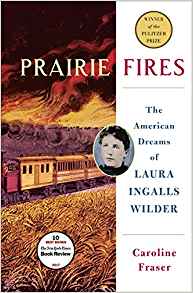 Caroline Fraser, Prairie Fires; The American Dreams of Laura Ingalls Wilder (New York: Metropolitan Books, 2017), 625pp.
Caroline Fraser, Prairie Fires; The American Dreams of Laura Ingalls Wilder (New York: Metropolitan Books, 2017), 625pp.
Of all the many books that my wife read aloud to our three children, none was more popular than the nine-volume series Little House on the Prairie by Laura Ingalls Wilder (1867–1957). In that regard we were not alone. The books have sold 60 million copies, been translated into 45 languages, turned into one of the longest-running shows in television history, and been the subject of numerous adaptations for stage and screen. Caroline Fraser's literary biography is a meticulous and comprehensive account of the books and their author that will be the new gold standard on the subject. The New York Times was only one of many papers to list Prairie Fires as one of the "best books" of 2017.
In addition to the fascinating rags-to-riches life of Wilder and her extended family, two major questions have always loomed over the books. First, are they true? Is this fiction or non-fiction? Are we reading a factual account of a little girl on the Great Plains of the 1800s, or is this a highly edited story that is closer to fiction? This is a complicated question, as Fraser shows, for many reasons, but this much can be said: when the first volume was published in 1932 it was marketed as fiction, not autobiography. "Wilder's 'truth' was less a matter of fact than of her memories, feelings, and convictions. Her work was based on facts but not factual. It was historical fiction, not history. Its chronology, and certain incidents and characters, were invented, altered, and fictionalized." (396).
Second, what role did Wilder's only child Rose Wilder Lane (1886–1968) play? Did she ghost write the books? A large part of Fraser's book explores the deeply complicated and volatile relationship between mother and daughter. Indeed, there is a separate, comprehensive biography on Lane, who was a deeply troubled person — a shameless liar and tabloid journalist, impulsive, profligate, perhaps bi-polar, and subject to several nervous breakdowns. It's now clear that Lane took Wilder's drafts and polished them with her considerable literary talent (and marketing skills).
Wilder's Little House books are what Fraser calls "a profound act of American myth making," about the rugged individualism and self-reliance of the early homesteaders, remembered through an idealized and even romantic lens. The books leave you with a carefully calculated feeling of the pioneer's triumph against all odds. The reality of Wilder's pioneer life was far different. It was a life of unimaginable privation, near-starvation, exhaustion, failure, poor choices, unpaid debts, constant moving, and regret. By the time she was eighteen, Wilder had lived in a dozen homes. Roughly half the pioneer farmers failed. "My life has been mainly disappointments," said Pa late in life. For Wilder herself, her memories as a little girl represented both "treasure and torment," both "sunshine and shadow."


